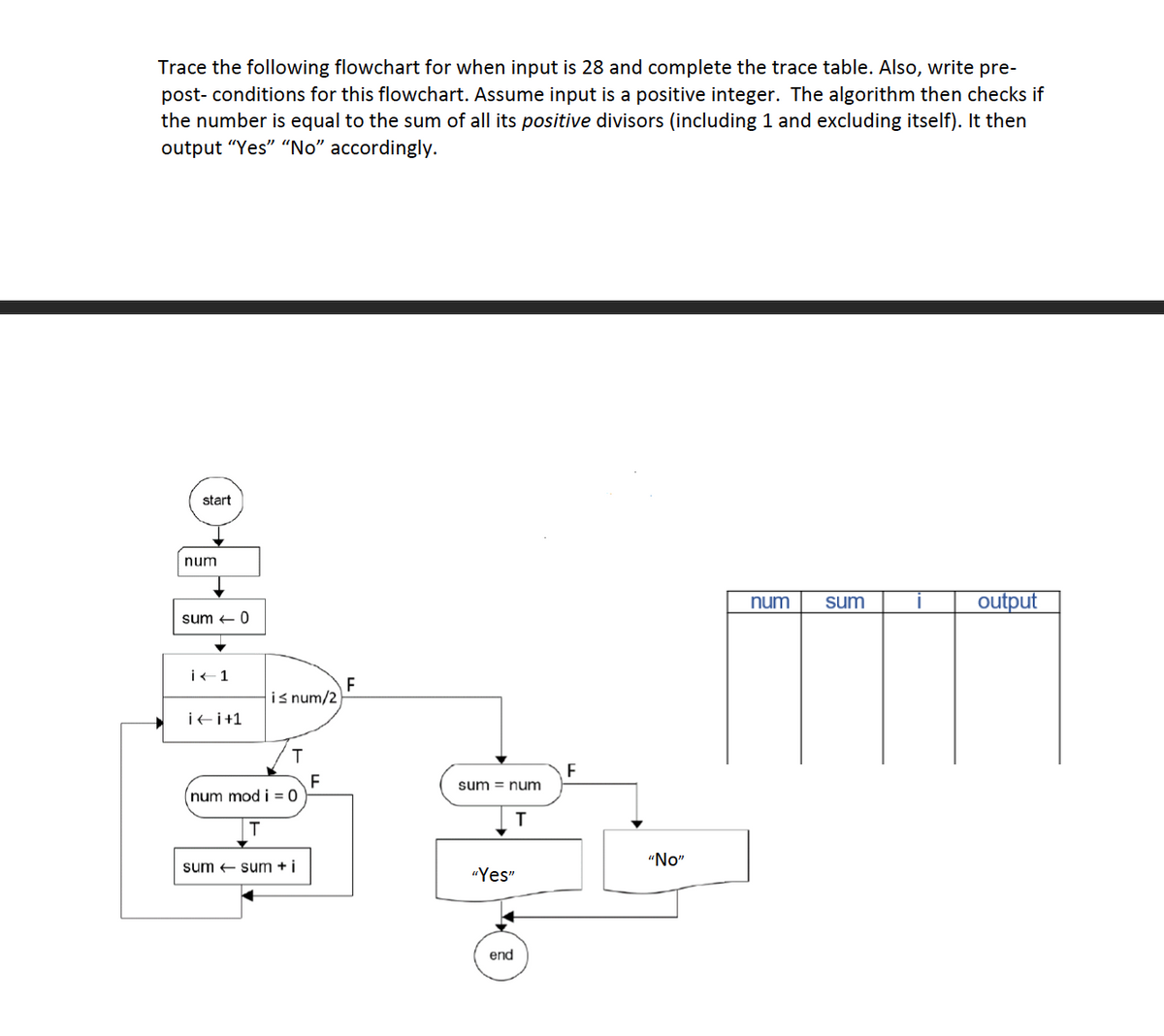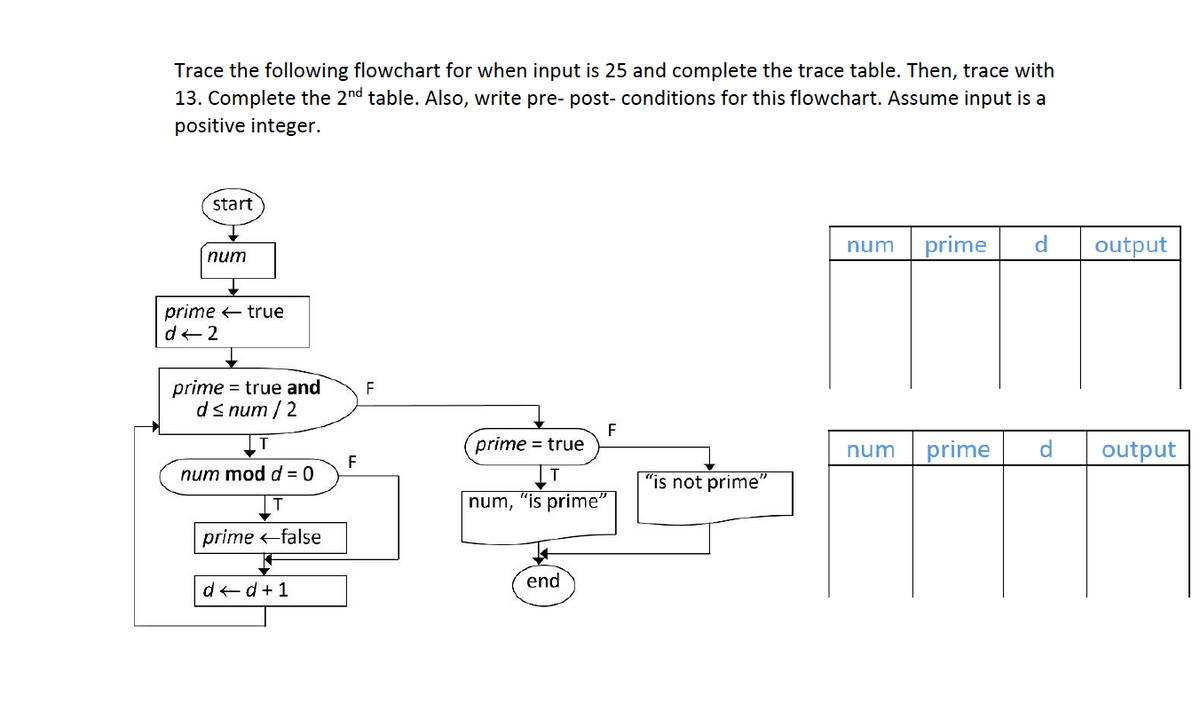Trace the following flowchart for when input is 28 and complete the trace table. Also, write pre- post-conditions for this flowchart. Assume input is a positive integer. The algorithm then checks if the number is equal to the sum of all its positive divisors (including 1 and excluding itself). It then output "Yes" "No" accordingly.
Trace the following flowchart for when input is 28 and complete the trace table. Also, write pre- post-conditions for this flowchart. Assume input is a positive integer. The algorithm then checks if the number is equal to the sum of all its positive divisors (including 1 and excluding itself). It then output "Yes" "No" accordingly.
Database System Concepts
7th Edition
ISBN:9780078022159
Author:Abraham Silberschatz Professor, Henry F. Korth, S. Sudarshan
Publisher:Abraham Silberschatz Professor, Henry F. Korth, S. Sudarshan
Chapter1: Introduction
Section: Chapter Questions
Problem 1PE
Related questions
Question

Transcribed Image Text:Trace the following flowchart for when input is 28 and complete the trace table. Also, write pre-
post-conditions for this flowchart. Assume input is a positive integer. The algorithm then checks if
the number is equal to the sum of all its positive divisors (including 1 and excluding itself). It then
output "Yes" "No" accordingly.
start
num
sum 0
▼
i<1
ii+1
is num/2
T
(num mod i=0
sum sum +i
F
sum num
T
"Yes"
end
F
"No"
sum
output
ITTTI
num

Transcribed Image Text:Trace the following flowchart for when input is 25 and complete the trace table. Then, trace with
13. Complete the 2nd table. Also, write pre- post- conditions for this flowchart. Assume input is a
positive integer.
start
num
prime ← true
d← 2
prime = true and
d≤ num / 2
num mod d=0
prime ←false
K
d< d + 1
F
F
prime = true
T
num,
"is prime"
end
F
"is not prime"
num
num
prime d
prime d
output
output
Expert Solution
This question has been solved!
Explore an expertly crafted, step-by-step solution for a thorough understanding of key concepts.
Step by step
Solved in 4 steps

Knowledge Booster
Learn more about
Need a deep-dive on the concept behind this application? Look no further. Learn more about this topic, computer-science and related others by exploring similar questions and additional content below.Recommended textbooks for you

Database System Concepts
Computer Science
ISBN:
9780078022159
Author:
Abraham Silberschatz Professor, Henry F. Korth, S. Sudarshan
Publisher:
McGraw-Hill Education

Starting Out with Python (4th Edition)
Computer Science
ISBN:
9780134444321
Author:
Tony Gaddis
Publisher:
PEARSON

Digital Fundamentals (11th Edition)
Computer Science
ISBN:
9780132737968
Author:
Thomas L. Floyd
Publisher:
PEARSON

Database System Concepts
Computer Science
ISBN:
9780078022159
Author:
Abraham Silberschatz Professor, Henry F. Korth, S. Sudarshan
Publisher:
McGraw-Hill Education

Starting Out with Python (4th Edition)
Computer Science
ISBN:
9780134444321
Author:
Tony Gaddis
Publisher:
PEARSON

Digital Fundamentals (11th Edition)
Computer Science
ISBN:
9780132737968
Author:
Thomas L. Floyd
Publisher:
PEARSON

C How to Program (8th Edition)
Computer Science
ISBN:
9780133976892
Author:
Paul J. Deitel, Harvey Deitel
Publisher:
PEARSON

Database Systems: Design, Implementation, & Manag…
Computer Science
ISBN:
9781337627900
Author:
Carlos Coronel, Steven Morris
Publisher:
Cengage Learning

Programmable Logic Controllers
Computer Science
ISBN:
9780073373843
Author:
Frank D. Petruzella
Publisher:
McGraw-Hill Education